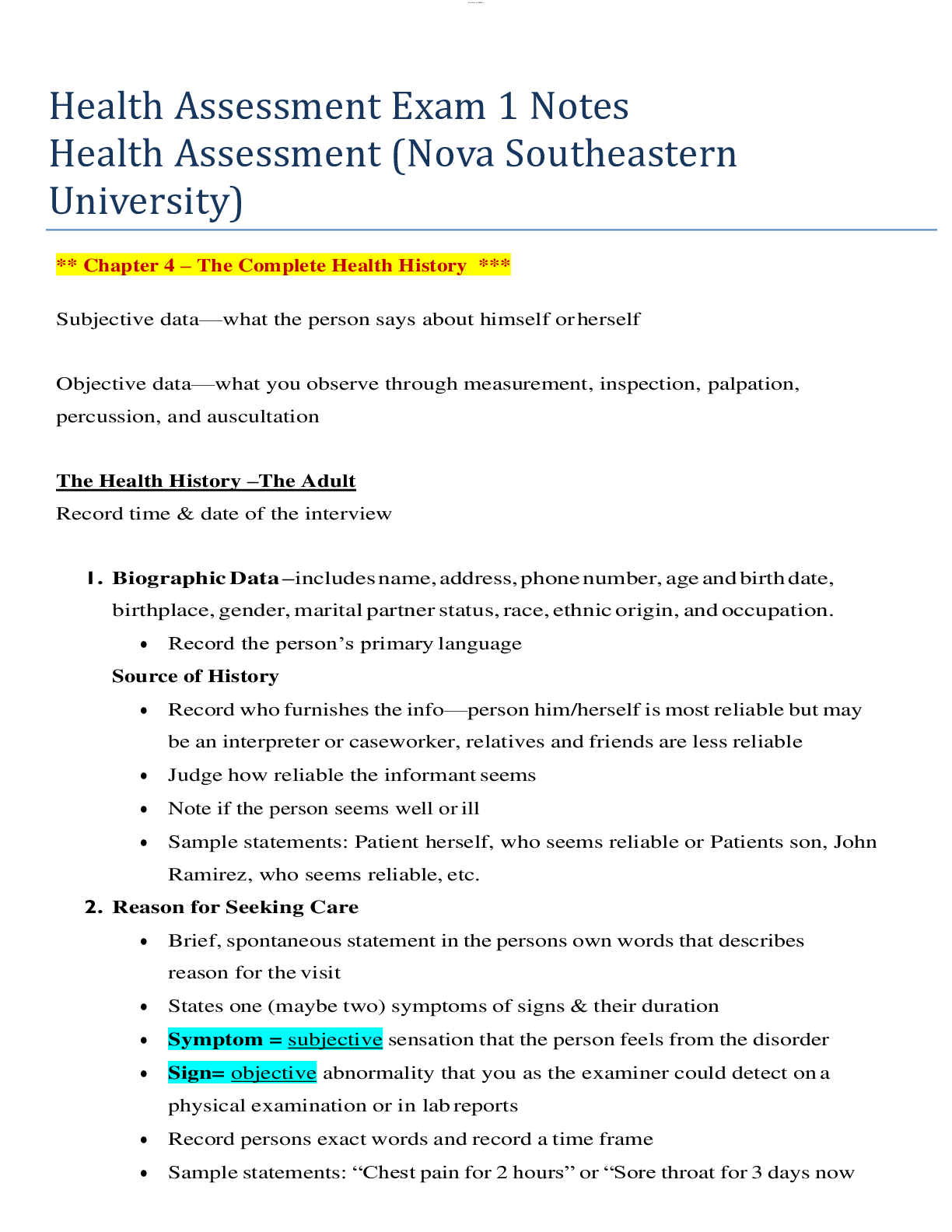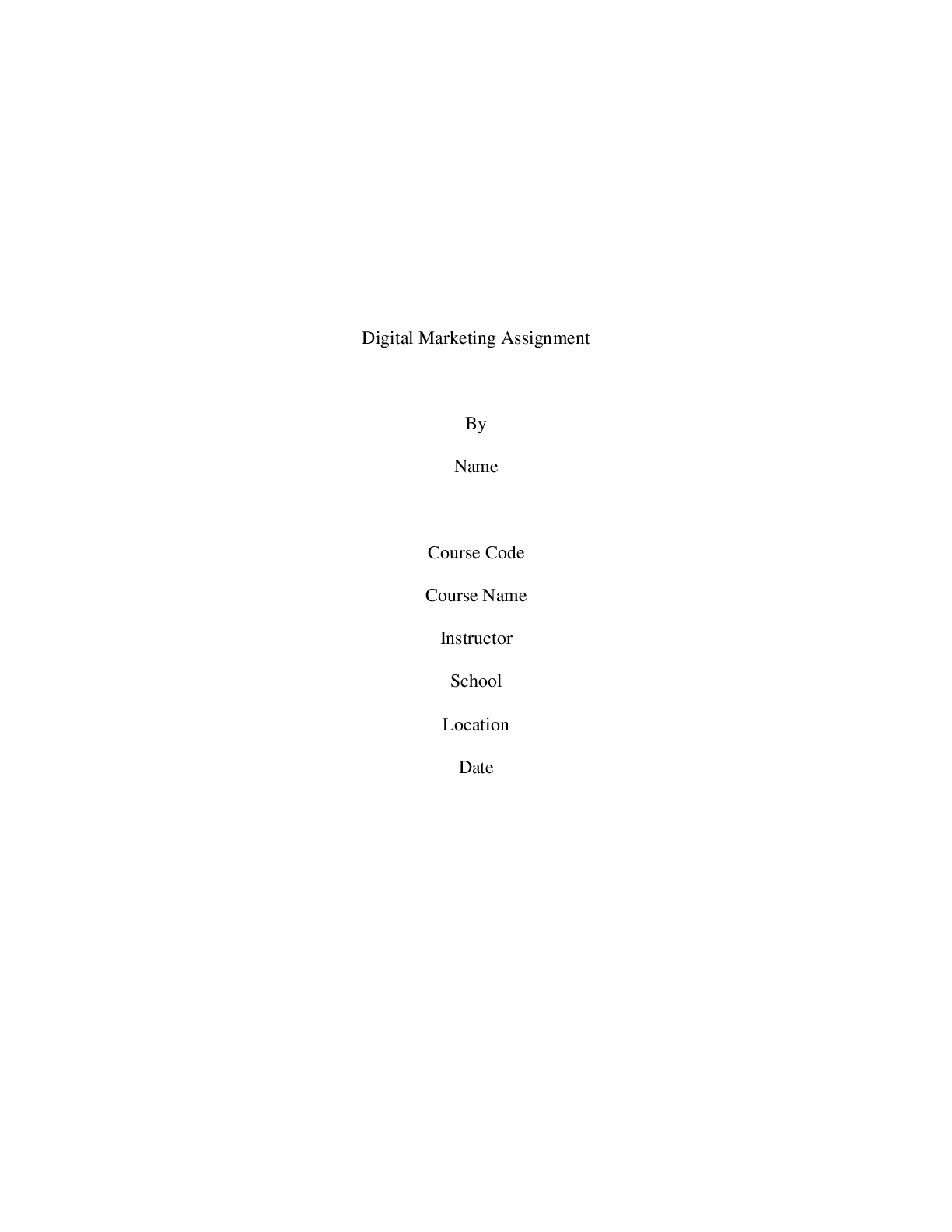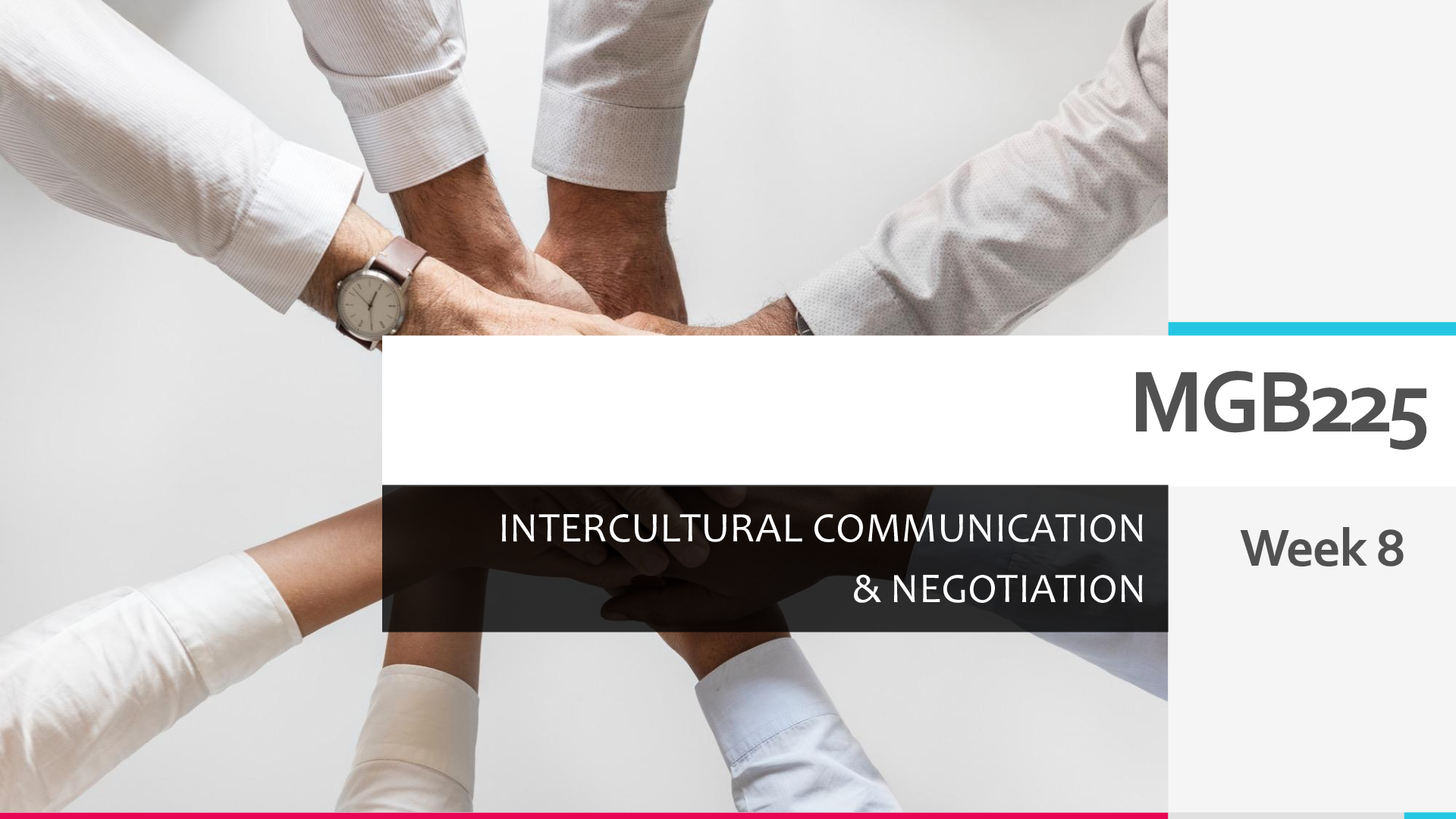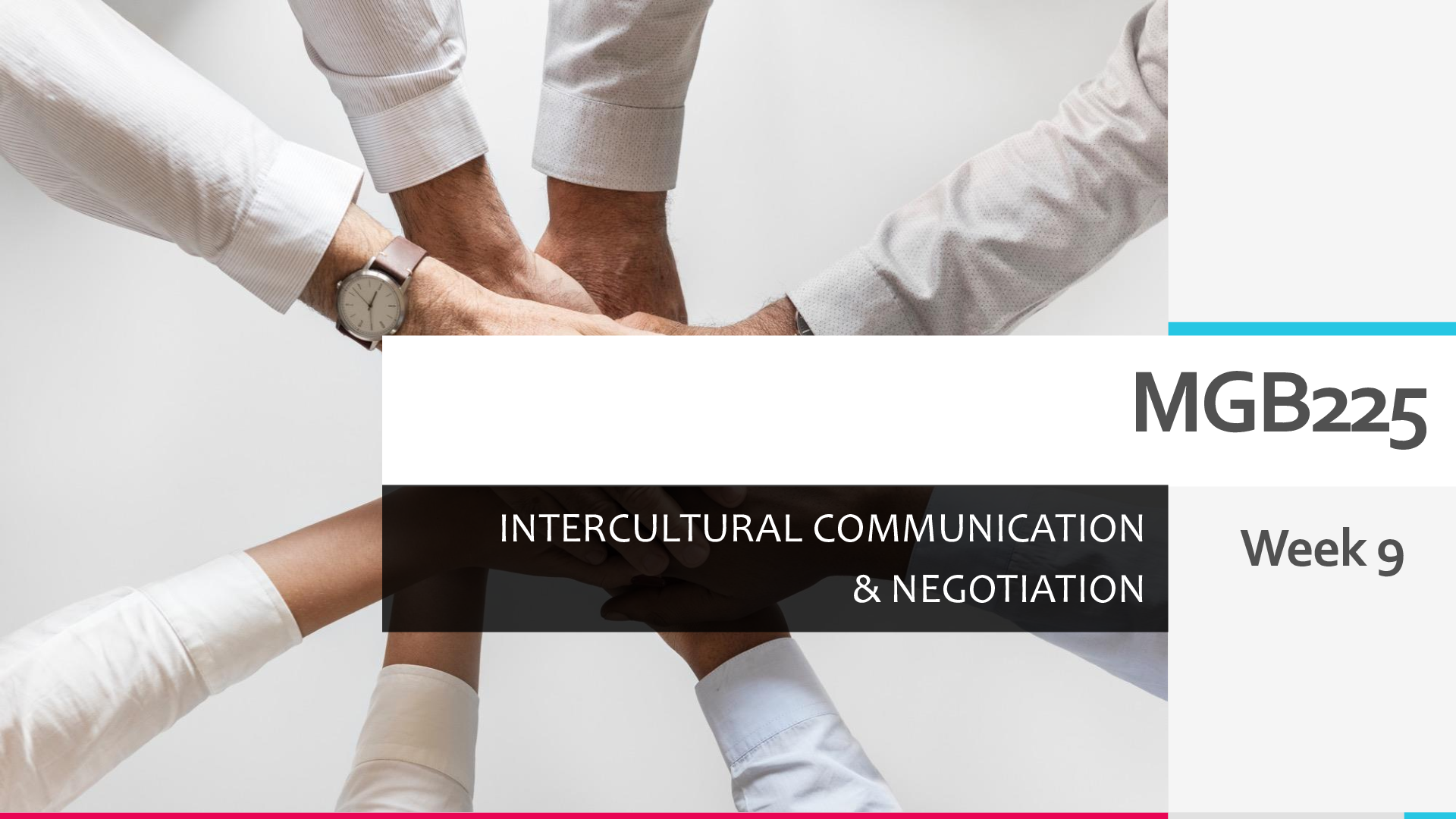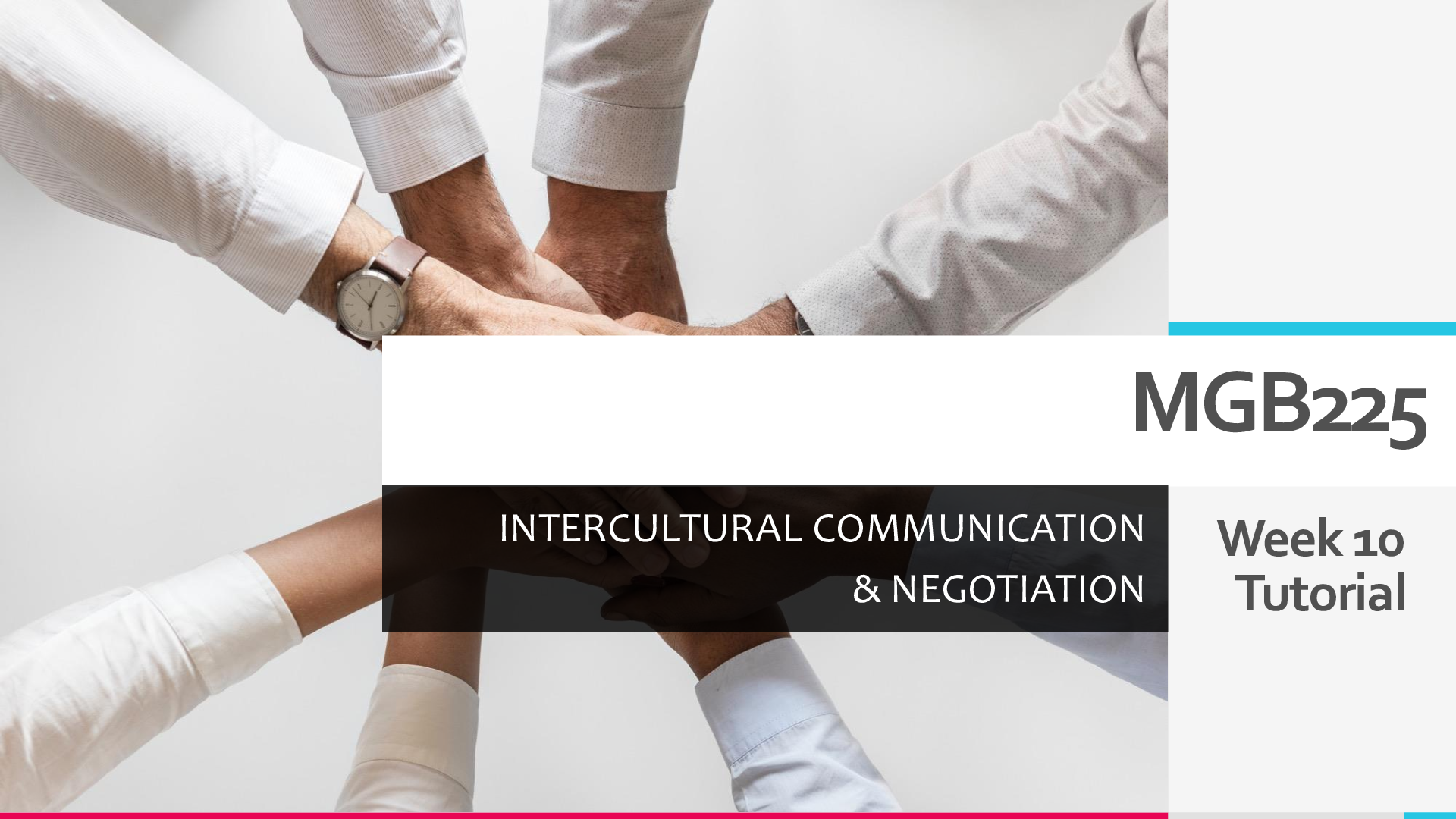Communication > Class Notes > MGB225: INTERCULTURAL COMMUNICATION & NEGOTIATION. Week 7 (All)
MGB225: INTERCULTURAL COMMUNICATION & NEGOTIATION. Week 7
Document Content and Description Below
MGB225 INTERCULTURAL COMMUNICATION & NEGOTIATION Week 72 Lecture learning objectives Identify the characteristics of international negotiations Show how business partnerships across bord... ers follow various models for decision-making Explain the partnership life cycle including the challenges that may arise Elaborate on assessment 2 instructions for the group reflection and CRA Negotiation in business practice3 Context of international negotiations 1. Immediate context • Includes factors over which negotiators appear to have some control 2. Environmental context • Includes environmental forces that neither negotiator controls that influence the negotiation4 Contexts bearing an influence on international negotiations5 Implications of cultural differences on decision-making • High power distance cultures • Will be more likely to have decision-making concentrated at the top which could affect length of negotiation if supervisors require consultation • High context cultures dislike uncertainty avoidance • Will seek stable rules & procedures & thus, are less comfortable w/ambiguous situations • Highly collectivist-oriented societies • Will focus on relationships using the same negotiators • Highly driven career success cultures • Will be prompted towards competitiveness as opposed to displaying empathy for the opponent, leaning towards compromiseTOP 10 RANKING COUNTRIES BY HOFSTEDE CULTURAL DIMENSIONS 6 Individualism Power Career Success/ Uncertainty Distance Quality of Life Avoidance 1. United States 1. Malaysia 1. Sweden 1. Greece 2. Australia 2. Guatemala 2. Norway 2. Portugal 3. Great Britain 3. Panama 3. Netherlands 3. Guatemala 4. Canada 4. Philippines 4. Denmark 4. Uruguay 5. Netherlands 5. Mexico 5. Costa Rica 5. Belgium 6. New Zealand 6. Venezuela 6. Yugoslavia 6. Salvador 7. Italy 7. Arabic Countries 7. Finland 7. Japan 8. Belgium 8. Ecuador 8. Chile 8. Yugoslavia (former) 9. Denmark 9. Indonesia 9. Portugal 9. Peru 10. France 10. India 10. Thailand 10. Argentina Adapted from (Hofstede, 1991)7 Schwartz’s 10 cultural valuesMANAGERIAL PERSPECTIVES Influence of culture on negotiation • Definitions of negotiation • Negotiation opportunity • Selection of negotiators • Protocol • Communication • Time sensitivity • Risk propensity • Groups versus individuals emphasis • Nature of agreements • Emotionalism 810 ways culture can influence negotiation 9 Negotiation Factors Definition Negotiation Opportunity Selection of Negotiators Protocol Communication Range of Cultural Responses Contract Distributive Experts Informal Direct Relationship Integrative Trusted Associates Formal Indirect10 ways culture can influence negotiation 10 Negotiation Factors Time Sensitivity Risk Propensity Groups vs. Individuals Nature of Agreements Emotionalism Range of Cultural Responses High High Collectivism Specific High Low Low Individualism General LowComparing negotiation styles 11 JAPANESE Hide emotions ____________________ ____________________ Cultivate a good emotional social setting for decision-making Not argumentative; quiet when right ____________________ What is down in writing must be accurate, valid NORTH AMERICANS Deal impersonally Profit or good of the individual is ultimate aim _____________________ _____________________ ____________________ Argumentative when right or wrong, but act impersonally Face-saving does not always matter _____________________ _____________________ LATIN AMERICANS What is good for the group is good for the individual Personalism is necessary for good decision-making _____________________ _____________________ Face-saving is crucial in decision-making to preserve honour Impatient with documentation (Deresky, 2011)RESEARCH PERSPECTIVES Influence of culture on negotiation 1213 Literature on influence of culture on negotiation Outcomes • Culture has an effect on negotiation outcomes, although it may not be direct • It likely has an influence through differences in the negotiation process in different cultures • Some evidence suggests that cross-cultural negotiations yield poorer outcomes than intracultural negotiations14 Model of culture & negotiation in business Culture 1: Manager 1’s normative beliefs about uncertainty and social control Culturally compatible negotiation style Manager 1’s negotiation style Culture 2: Manager 2’s normative beliefs about uncertainty and social control Culturally compatible negotiation style Manager 2’s negotiation style Other influences on negotiation process (Steers, Sanchez-Runde & Nardon, 2010)15 Culturally responsive negotiation strategies Strategies are arranged based on the level of familiarity that a negotiator has with the other party’s culture at these levels: • Low • Moderate • High16 Low familiarity 1. Employ agents or advisers (unilateral strategy) • Useful for negotiators who have little awareness of the other party’s culture 2. Bring in a mediator (joint strategy) • Encourages one side or the other to adopt one cultural approach or the mediator’s preferred cultural approach 3. Induce the other party to use your approach (joint strategy) • The other party may become irritated or be insulted17 Moderate familiarity 1. Adapt to the other negotiator’s approach (unilateral strategy) • Involves making conscious changes to your approach so it is more appealing to the other party 2. Coordinate adjustment (joint strategy) • Involves both parties making mutual adjustments to find a common process for negotiation18 High familiarity 1. Embrace the other negotiator’s approach (unilateral strategy) • Adopting completely the approach of the other negotiator (negotiator needs to be completely bilingual and bicultural) 2. Improvise an approach (joint strategy) • Craft an approach that is specifically tailored to the negotiation situation, other party, and circumstances at hand 3. Effect symphony (joint strategy) • The parties create a new approach that may include aspects of either home culture or adopt practices from a third culture19 Caveat Negotiators risk treating their counterparts as cultural ambassadors rather than unique, multifaceted human beings. PON Staff, Harvard Law School, July 201420 Schematic overcompensation Both sides try too hard to adapt to their stereotypical ideas about the other side’s negotiating style, which often leads to cultural clashes. • e.g. American vs. Japanese professionals • e.g. Academics vs. diplomats Tips for avoiding a cultural clash: • Consider the individual • Broaden your scope • Reduce stress PON Staff, Harvard Law School, July 201421 Benefits of multicultural perspectives • People with bicultural backgrounds engage in more complex thinking than those from a single cultural background (Benet-Martinez, 2012) • Individuals who have lived abroad tend to be more creative than those who have not (Godart, F. C., Maddux, W. W., Shipilov, A. V., & Galinsky, A. D., 2015). • The sensitivity to a variety of practices, customs, and perspectives translates into a keen ability to understand a counterpart’s motives and interests; and thus, is the reason why it pays to have a bicultural individual on at least one side of the negotiation table (PON Staff, March 2011)Partnering Partnerships as organisations Their structure varies from: • One-on-one relationships • Networks • Legal entity, e.g. joint venture It depends on mutual interests, availability & experience of staff, contribution of resources & urgency & scale of efforts. Commonly conflicts arise due to organisational & cultural differences: • Status & power differences • Intergroup dynamics • Insufficient time lent to build relationships • Power flows & constraints on learning • Misconceptions about partner(s) • Inadequate effort & energy • Different management styles As cultural complexities increase, so do challenges across cultures23 Key to problem-solving is collaboration • Develop strong, healthy relationships based on trust • Committed to cooperate for new knowledge, goods or services Opportunities • Meetings are ‘communication events’ (Schwartzman, 1993) • Culture affects how they are organised, managed & integrated in business24 Meeting styles differ 1. Purposes, e.g. decisions vs. consensus 2. Time allocation, e.g. minimum or maximum work view 3. Content & format, e.g. structure & order 4. Types of national culture to determine: • Who is talking—a leader, select group or all the participants? • Can anyone present material or offer ideas? • Whose views matter? • Is there a person or format to keep the flow?25 Decision-making models of partnerships Clearly defining the parameters of a project is critical to success between partners Prevailing models include: 1. Majority preferred – seeking buy-in from leaders to form an alliance 2. 100% consensus – team representing range of levels & functions 3. Leadership driven – yet, based on group assessment 4. Single voice of authority – yet, assigning a task to subordinates (vertical relationship) 5. Individual empowerment – employees are specialists & free to make decisions that were frequently resisted or changed 6. Interdependence – colleagues exchange information that is complemented by formal decision-making of a person charged w/task (horizontal relationship)26 Lessons of models Multiple & distinctive patterns of decision-making can lead to partnership paralysis or conflict. High-performing partners use sharing strategies for success: • cultural crossvergence (Sarala & Vaara, 2010); cultural synergy (Adler, 1997); or hybrid culture (Gluesing & Gibson, 2004) Observations: • Decision-making is mostly tied w/organisational over national cultures, but subcultural groups are another influence • Individuals or peers can play a central role in decision-making besides supervisors • Similarly, groups or individuals can take responsibility27 Partnering relationships 1. Reciprocity at home & abroad • Sharing information/insights; joint work; understanding, mutual respect & trust (Trotter II, 2008a, 2008b) 2. Distinctions in interactions exist between local and global teams, particularly using ICT • Virtual vs. face-to-face communication across work situations • This topic will be covered more in-depth in the week 10 lecture28 Life cycle of partnerships Stages 1. Initiation – mix of tech, managerial & support personnel form a network w/core & periphery 2. Start-up – relationships develop w/communication & coordination, but there is some tension to adjust 3. Growth – core players focus on goals/direction & integrate specific tasks of outliers 4. Mature – subgroups emerge from mix to reach goals jointly 5. Transition – modifications occur based on outcomes 1. Continue w/minimal change 2. Add or delete tech areas 3. Split the partnership in functioning areas 4. End the partnership29 Partnering relationships – process of problem solving 1. Partnership rules – unwritten descriptions to make it work effectively • Consider what has to be solved • Ensure mutual benefit • Attain product or service to satisfy customers 2. Local rules in specific departments may exist 3. Cultural experts can be facilitators • Broker deals across diverse interaction styles • Explore how to cater products to suit customer needs Inter- & intraorganisational cultures30 Evolution of partnerships Conflict, misunderstanding & miscommunication is a natural facet of interactions To mitigate: • Develop open, mutually respectful relationships • Make assumptions & expectations as transparent as possible • Identify & address ambiguities & disagreements in a timely manner Overall partnerships matter so expend effort • Strategise to uncover & resolve difficulties • Compare progress to goals • Cultivate relationships at all levels for success31 Assessment 2 The purpose of this piece of assessment is to evaluate your ability to work as a member of a negotiation team and assess your group's ability to plan, prepare, participate and demonstrate skills in an intercultural communication and negotiation context and evaluate your negotiation outcome. There are three components to this assessment item (2 x negotiation plans PLUS 1 x group reflection). These components relate to two negotiation simulations in the tutorials in weeks 8 and 10. You will be required to submit planning forms prior to the start of each simulation. And then after the week 8 simulation, your team will write a reflective essay that identifies a number of critical moments or events during the negotiation simulation, due in week 9. Marks incorporate self and peer assessment of group processes. The planning forms are due on the days before the respective negotiations, in weeks 8 and 10. The group reflection (1,500 words) based on the week 8 simulation is due in week 9. Now we will review the instructions & CRA…32 Summary Discussion on international negotiation was complemented with outlook on partnering across cultures Unveiled all the instructions for completing the group reflection for assessment 233 Tutorial this week • Workshop on reflective writing for completing assessments 2 & 3 Next week Lecture: Multiparty and Team Negotiation • Tutorial: Negotiation Simulation 3 (Assessment)34 References Adler, N. (1997). International dimensions of organizational behavior (3rd ed.) Cincinnati, OH: Southwestern. Benet-Martinez, V. Multiculturalism: Cultural, social and personality processes. In K. Deaux & M. Snyder (Eds.), Handbook of Personality and Social Psychology. Oxford University Press. Deresky, H. (2011). International management: Managing across borders and cultures (7th ed.). Upper Saddle River, NJ: Prentice Hall. Ferrarro, G. P., & Briody, E. K. (2017). The cultural dimension of global business (8th edition). Oxon & New York, Routledge. Gluesing, J.C. & Gibson, C. (2004). Designing and forming global teams. In H.W. Lane, M.L. Maznevski, M.E. Mendenhall, & J. McNett (Eds.), Handbook of global management: A guide to managing complexity. Oxford, UK: Blackwell. Godart, F. C., Maddux, W. W., Shipilov, A. V., & Galinsky, A. D. (2015). Fashion with a foreign flair: Professional experiences abroad facilitate the creative innovations of organizations. Academy of Management Journal, 58(1), 195-220. Hofstede, G. (1991) Culture and organizations: Software of the mind. London, UK: McGraw-Hill Book Company Europe. Lewicki, R.J., Saunders, D.M., & Barry, B. (2010). Essentials of negotiation (5th ed.). New York: McGraw-Hill.35 References PON Staff, Harvard Law School (2014). International negotiations: When negotiators try too hard. Retrieved from https://www.pon.harvard.edu/daily/conflict-resolution/intercultural-negotiations-when-negotiatorstry-too-hard/, July 25. PON Staff, Harvard Law School (2011). When two cultures are better than one. Retrieved from https://www.pon.harvard.edu/daily/negotiation-skills-daily/when-two-cultures-are-better-than-one/, March 15. Sarala, R.M. & Vaara, E. (2010). Cultural differences, convergence, and crossvergence as explainations of knowledge transfer in international acquisitions. Journal of International Business Studies 41, 1365-1390. Schwartzman, H.B. (1993). Ethnography in organization in Qualitative research methods. 27. Newbury Park, CA: Sage Publications. Steers, R. M., Sanchez-Runde, C. J., & Nardon, L. (2010). Management across cultures. New York: Cambridge. Trotter, R.T., Briody, E.K., Sengir, G.H., & Meerwarth, T.L. (2008a). The life cycle of collaborative partnerships: Evolutionary structure in industry-university research networks. Connections (International network for social network analysis) 28(1), 40-58, June. Trotter, R.T., II, Sengir, G.H., & Briody, E.K. (2008b). The cultural processes of partnerships. In E.K. Briody & R.T. Trotter (Eds.), Partnering for organizational performance: Collaboration and culture in the global workplace. Lanham, MD: Rowman and Littlefield. [Show More]
Last updated: 2 years ago
Preview 1 out of 35 pages
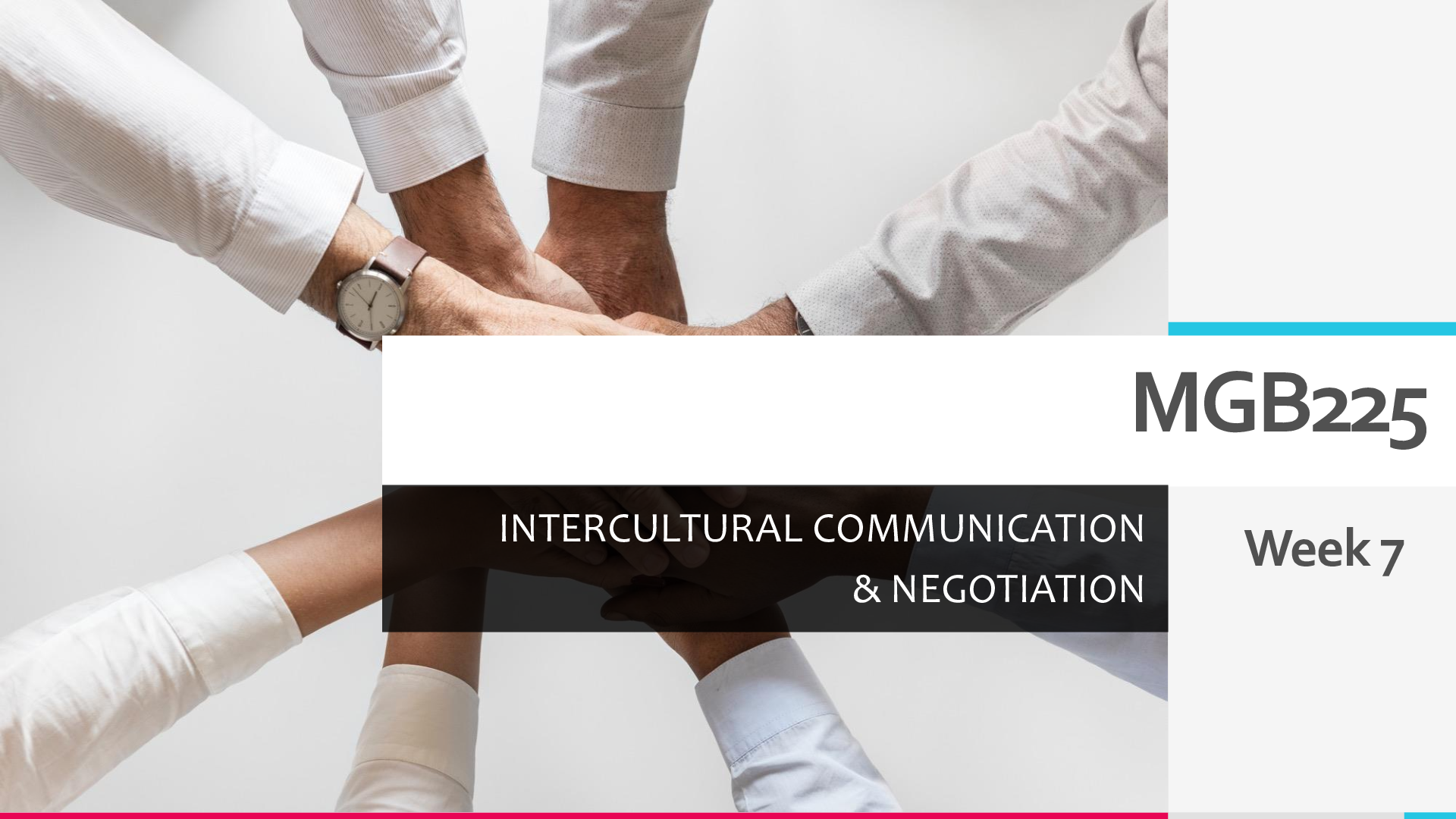
Buy this document to get the full access instantly
Instant Download Access after purchase
Buy NowInstant download
We Accept:

Reviews( 0 )
$3.00
Can't find what you want? Try our AI powered Search
Document information
Connected school, study & course
About the document
Uploaded On
Feb 02, 2020
Number of pages
35
Written in
Additional information
This document has been written for:
Uploaded
Feb 02, 2020
Downloads
0
Views
140




